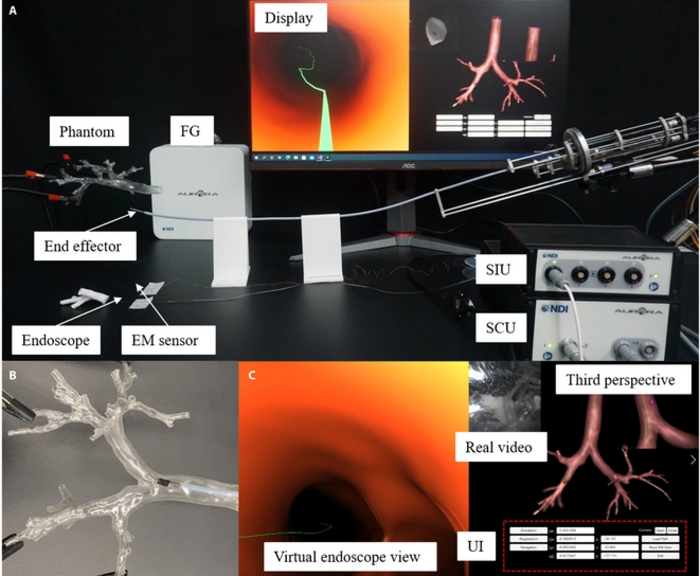
Roboticists from Beijing Institute of Technology proposed a robotic bronchoscope system aiming for the biopsy of pulmonary lesions. Image Credit: Cyborg and Bionic Systems
Lung cancer, like other cancers, can be treated more successfully if detected early.
According to Duan and his colleagues, early detection of lung cancer is crucial for prompt treatment and better prognoses. To do this, they developed a unique robotic bronchoscope device that can non-invasively reach the lung’s area of concern for minimally invasive pulmonary lesions sampling, the gold standard for diagnosing lung cancer. The journal Cyborg and Bionic Systems published this study on March 15th, 2023.
The authors of the study stated, “Imagine inserting a long thin line into your mouth, through your airway to cut a little part of the lesion of interest within your lung. After that, this thin line brings the cut sample back for further examination to determine whether it is benign or malignant. This is what the bronchoscope system was designed for. Our end effector is just like a thin line. To do so, this line must first be thin enough to cross the trachea and bronchus.”
Changsheng Li, the corresponding author of this study, from the School of Mechatronical Engineering, Beijing Institute of Technology, added, “Moreover, it must be able to bend, rotate and translate to flexibly navigate the complex airway network.”
They further added, “Another problem is that you can’t see the end effector of this line through the patient’s chest. However, to accurately approach the lesion of interest, the position and pose of the end effector must be determined in real-time.”
They developed a navigation system to solve this issue, attaching an endoscope and two electromagnetic sensors to the end effector, enabling online positioning for navigation and providing visual data for doctors to diagnose and sample.
When a target location is selected, and a robotic path is to be planned, the navigation system additionally reconstructs a three-dimensional virtual model based on computed tomography.
The robotic bronchoscope system can deliver intraoperative visual guidance for biopsy sampling while automatically locating the target lesion by combining the flexible end effector with the navigation system.
Through an ex vivo navigation-assisted intervention trial, they confirmed the viability of their robotic bronchoscope system.
Li further added, “During the experiment, the position displayed by the third perspective of the virtual endoscope is consistent with the position of the end effector’s tip relative to the airway phantom from visual observation. The virtual endoscope view also matches with the real video acquired by the endoscope module as expected.”
“Although the system has achieved promising bronchoscopy performance, as a medical device, there are still some issues that limit the clinical application and promotion. First of all, the more convenient maneuver is required for surgeons to readily learn and use; Second, high-resolution endoscopic view is required; Finally, the calibration between virtual and actual environments is still time-consuming and unfriendly to the novice,” study authors stated.
In the future, they will concentrate on reducing the diameter of the end effector and adopting replaceable modules for a variety of surgical requirements, researching joint control to enable the robot to move more freely in the airway, and implementing computer vision algorithms to achieve automatic and intelligent calibration.
Xingguang Duan, Dongsheng Xie, Runtian Zhang, Xiaotian Li, Jiali Sun, Chao Qian, Xinya Song, and Changsheng Li are the authors of the study.
The National Natural Science Foundation of China, the Beijing Municipal Natural Science Foundation-Haidian Primitive Innovation Joint Fund Project, and the National Natural Science Foundation of China-Shenzhen Robotics Research Center Project provided funding for the study.
Journal Reference
Li, J., et al. (2023) Biohybrid Micro- and Nanorobots for Intelligent Drug Delivery. Cyborg and Bionic Systems. doi:10.34133/2022/9824057.